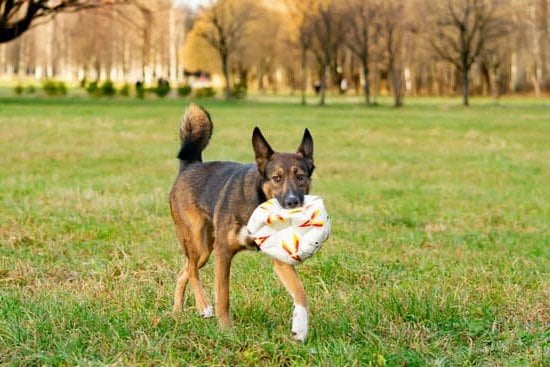Are you struggling with a dog that has a biting habit? Understanding the root cause of biting behavior is crucial in addressing this issue. Fear, anxiety, aggression, and teething are just some of the reasons why dogs bite. Before you can effectively train your dog to stop biting, it’s essential to identify the underlying cause driving this behavior.
Positive reinforcement training methods have been proven to be effective in addressing biting behavior in dogs. By rewarding good behavior with treats or praise, you can encourage your dog to exhibit non-biting behavior. These methods not only address the biting problem but also strengthen the bond between you and your furry friend.
Socialization plays a key role in preventing biting behavior in dogs. Early exposure to different environments and stimuli helps reduce fear-based aggression. Additionally, redirecting biting and chewing behavior towards appropriate toys and objects is an effective strategy for managing this issue.
Remember, consistency and clear communication are vital elements in training a dog to stop biting. It is also important to recognize when professional training and guidance may be necessary for more severe cases of biting behavior. With patience and persistence, it is possible to train your dog to overcome their biting habit.
Positive Reinforcement Training Methods
When it comes to addressing biting behavior in dogs, positive reinforcement training methods have shown to be highly effective in modifying their behavior. Positive reinforcement involves rewarding the dog for exhibiting the desired behavior, which can help them understand what is expected of them and encourage them to repeat those behaviors. Here are some examples of positive reinforcement techniques that can be used to train a dog to stop biting:
- Treats: When the dog exhibits non-biting behavior, such as licking instead of biting, offer them a small treat as a reward. This will help them associate not biting with receiving a reward, making it more likely for them to continue the non-biting behavior.
- Praise: Verbal praise and affection can also serve as effective rewards for good behavior. When your dog refrains from biting and instead engages in gentle play or interaction, verbally praise them and give them affection to reinforce the desired behavior.
- Clicker Training: Clicker training can be used to mark the exact moment when the dog exhibits non-biting behavior, followed by a treat or praise. This helps to clearly communicate to the dog which specific behaviors are being rewarded.
By consistently using positive reinforcement techniques, dog owners can effectively train their dogs to stop biting by encouraging and rewarding non-biting behaviors.
In addition to positive reinforcement, it’s important for dog owners to remain patient and persistent throughout the training process. It may take time for a dog to unlearn biting behaviors and adopt new ones, so consistency and dedication are key in successfully modifying their behavior. With patience and persistence, along with the use of positive reinforcement training methods, it is possible to train a dog to stop biting and promote gentler interactions.
Socialization and Exposure to Different Environments
When it comes to training a dog to stop biting, socialization and exposure to different environments play a crucial role in preventing this behavior. Early socialization of puppies is essential in helping them feel comfortable and confident around people, other dogs, and various stimuli. This can greatly reduce fear-based aggression and the tendency to resort to biting when feeling threatened or anxious.
Proper socialization involves gradually introducing puppies to new experiences, such as different sounds, sights, smells, and environments. This helps them become familiar with these stimuli and reduces the likelihood of reacting aggressively out of fear or insecurity. Additionally, positive interactions with other dogs and humans during this critical period can teach puppies appropriate ways to interact without resorting to biting.
Exposing dogs to various environments also helps them become adaptable and less likely to feel stressed or threatened in unfamiliar situations. This can be achieved by taking your dog for walks in different places, visiting parks, beaches, or attending dog-friendly events where they can encounter new people and experiences. The more exposure they have to diverse environments, the less likely they are to feel anxious or display aggressive behavior like biting.
In addition to reducing the risk of biting behavior, early socialization and exposure provide numerous benefits for a dog’s overall well-being and mental development. It enhances their confidence, improves their ability to handle new situations calmly, and fosters positive interactions with both humans and other animals.
Ultimately, a well-socialized dog is less likely to resort to biting as a reaction to fear or anxiety. By prioritizing socialization and exposure from an early age, owners can set their dogs up for success in developing non-aggressive behaviors.
| Socialization Benefits | Exposure Benefits |
|---|---|
| Enhances dog’s confidence | Fosters adaptability |
| Improves ability to handle new situations calmly | Reduces stress in unfamiliar environments |
| Fosters positive interactions with humans and animals | Promotes non-aggressive behaviors |
Redirecting Biting and Chewing Behavior
Biting and chewing are normal behaviors for dogs, especially puppies who are teething and exploring their environment. However, it’s important to redirect this behavior towards appropriate toys and objects. By providing your dog with alternative items to chew on, you can effectively train them to stop biting people or furniture.
Offering Suitable Chew Toys
When training a dog to stop biting, it’s crucial to provide them with suitable chew toys that are safe and satisfying for their needs. Look for toys that are designed specifically for teething puppies or durable toys that can withstand strong chewing. Introduce these toys to your dog and encourage them to chew on these items instead of biting on people’s hands or clothing.
Teaching the “Leave It” Command
Another effective strategy for redirecting biting behavior is teaching the “leave it” command. This command can be used to discourage your dog from biting or mouthing inappropriate items. Start by offering a treat in one hand while firmly saying “leave it,” then rewarding your dog with the treat from the other hand when they comply. With consistent practice, your dog will learn to stop biting when given the “leave it” cue.
Supervision and Reinforcement
Consistent supervision is key when training a dog to stop biting. Whenever you notice your dog engaging in biting or chewing behavior, redirect their attention towards appropriate toys and reinforce this positive behavior with praise or treats. Over time, your dog will learn that chewing on toys is rewarded, while biting people or furniture is not.
By implementing these strategies for redirecting biting and chewing behavior, along with positive reinforcement techniques mentioned earlier in this article, you can effectively train your dog to stop biting and engage in more appropriate behaviors. Remember that patience and persistence are essential in the training process as your dog learns new habits.
Consistency and Clear Communication
Consistency in training is key when it comes to addressing biting behavior in dogs. It is important for dog owners to establish clear rules and boundaries, and to consistently enforce them. Dogs thrive on routine and structure, so maintaining a consistent approach to training will help them understand what is expected of them.
Using clear communication with your dog is essential in preventing biting incidents. This includes using firm, but gentle, commands and cues to convey your expectations. Avoid sending mixed signals to your dog, as this can lead to confusion and potentially escalate their biting behavior. Consistent communication will help your dog understand what behaviors are acceptable and what are not.
Setting clear boundaries through consistent communication also includes establishing consequences for undesirable behavior. For example, if your dog attempts to bite or mouth you, immediately communicate that this behavior is unacceptable through a firm “no” command or a redirection technique. Consistently enforcing these boundaries will help your dog understand that biting is not tolerated.
Establishing Routine
One way to maintain consistency in training and communication is by establishing a daily routine for your dog. This can include regular feeding times, exercise schedules, and designated training sessions. By following a consistent routine, your dog will become more familiar with the rules and expectations within the household.
Positive Reinforcement as a Tool for Clear Communication
In addition to setting clear boundaries, positive reinforcement can be used as a tool for clear communication with your dog. When your dog exhibits good behavior (e.g. refraining from biting), make sure to reward them with treats or praise. This positive feedback will convey the message that their non-biting behavior is desirable while reinforcing consistency in training.
By prioritizing consistency and clear communication in your approach to training, you will create an environment where your dog understands the rules and knows how to behave appropriately. This will ultimately contribute to preventing biting incidents while fostering a strong bond between you and your pet.
Overall, patience and persistence are vital throughout this process as progress may not happen overnight but with consistent effort you can train a dog to stop biting effectively over time using these techniques.
Professional Training and Guidance
When dealing with more severe biting behaviors in dogs, seeking professional training and guidance can be invaluable. Professional dog trainers or behaviorists have the expertise and experience to assess your dog’s specific needs and develop a tailored training plan to address the biting behavior. They can provide personalized guidance and support to help you effectively train your dog to stop biting.
Professional trainers and behaviorists often use a combination of positive reinforcement techniques, behavior modification strategies, and desensitization exercises to address biting behaviors in dogs. These professionals can also offer valuable insights into understanding the root cause of the biting behavior, whether it stems from fear, aggression, or other underlying issues. By addressing these underlying factors, professional trainers can work with you to create a comprehensive approach to stop your dog from biting.
It’s important to thoroughly research and select reputable dog trainers or behaviorists who have a proven track record of success in addressing biting behaviors. Look for professionals who use positive reinforcement methods and have certifications or credentials that demonstrate their expertise in dog training and behavior modification. Additionally, seek out recommendations from other dog owners or veterinarians to find a qualified professional who can provide the necessary training and guidance for your dog.
| Professional Training Methods | Benefits |
|---|---|
| Positive reinforcement techniques | Effective in modifying biting behavior |
| Behavior modification strategies | Addressing underlying causes of biting |
| Desensitization exercises | Reducing fear-based aggression |
Understanding Body Language and Communication From Dogs
As a responsible dog owner, it is essential to understand and interpret the subtle cues in your dog’s body language that may indicate the potential for biting. By recognizing these signals, you can take proactive steps to prevent biting incidents and address any underlying issues that may be causing the behavior. Here are some key aspects to consider when deciphering your dog’s body language:
- Facial Expressions: Pay attention to your dog’s facial expressions, such as tense or bared teeth, wrinkled muzzle, or licked lips, which can signal discomfort or aggression.
- Posture: The way your dog stands or moves can communicate a lot about their mood. A stiff stance, raised hackles, and a closed mouth may indicate that your dog is feeling threatened or anxious.
- Tail Wagging: While many people associate tail wagging with happiness, it can also signify agitation or overstimulation. Rapid tail wagging accompanied by tensed muscles could be a warning sign.
- Eyes: Dilated pupils and intense staring can indicate that your dog is feeling stressed or uncomfortable in a situation.
It’s also crucial to pay attention to how your dog communicates with you and other animals through vocalizations and body movements. Understanding these cues will help you respond appropriately and avoid potential biting incidents.
By learning to recognize and interpret your dog’s body language, you can effectively prevent situations that may lead to biting. This understanding will also enable you to address any underlying issues causing the behavior from fear and anxiety to aggression or any other potential triggers. Taking the time to learn about canine communication will greatly aid in keeping both you and your pet safe.
Furthermore, by being attuned to your dog’s body language, you can better adjust training methods according to their comfort level which ties back into positive reinforcement training methods. These understanding-based adjustments will foster trust between you and your pet which further facilitates curbing of biting behaviors using force-free training techniques based on mutual trust.
Patience and Persistence in Training
In conclusion, training a dog to stop biting requires patience, persistence, and a deep understanding of the underlying reasons for this behavior. It is crucial to first identify the root cause of biting, whether it stems from fear, anxiety, aggression, or teething. By understanding the motivation behind the behavior, dog owners can tailor their training approach to address the specific needs of their furry companion.
Positive reinforcement training methods have proven to be highly effective in modifying a dog’s behavior. Rewarding good behavior with treats or praise can help dogs understand what is expected of them and encourage them to repeat that behavior. Additionally, socialization from an early age and exposure to different environments are essential in preventing fear-based aggression that may lead to biting.
Furthermore, redirecting biting and chewing behavior towards appropriate toys and objects can help deter dogs from mouthing or nipping. Consistency in training and clear communication with your dog are also key components in conveying boundaries and expectations. While seeking professional training may be necessary for severe biting behaviors, it is important for dog owners to be patient and persistent throughout the whole process.
With time and dedication, most dogs can learn to overcome their biting tendencies and become well-behaved pets. Training a dog to stop biting is a journey that requires commitment but can ultimately result in a stronger bond between the pet and its owner.

Welcome to the blog! I am a professional dog trainer and have been working with dogs for many years. In this blog, I will be discussing various topics related to dog training, including tips, tricks, and advice. I hope you find this information helpful and informative. Thanks for reading!





